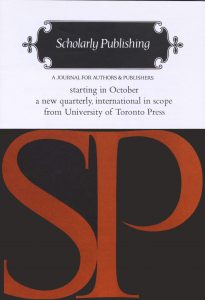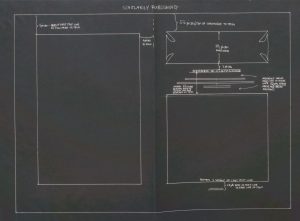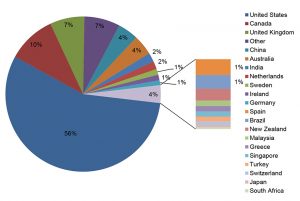Written by guest bloggers Mary Lui and Robert Brown.
Over the past fifty years, the Journal of Scholarly Publishing (previously called Scholarly Publishing: A Journal for Authors and Publishers) has created a vast community of authors, publishers, scholars, librarians, academic department heads, administrators of educational and fund-granting bodies, and readers.
 Marsh Jeanneret, Director of Press, 1953–1977, on January 22, 1976. Image courtesy of the University of Toronto Archives/Robert Lansdale Photography, Ltd. (digital image no. 2001-77-209MS).
Marsh Jeanneret, Director of Press, 1953–1977, on January 22, 1976. Image courtesy of the University of Toronto Archives/Robert Lansdale Photography, Ltd. (digital image no. 2001-77-209MS).
But where did the idea for the journal come from in 1969? To answer this question, we must look back to Press Notes, a monthly published by the University of Toronto Press. The first issue of Press Notes, in 1953, was sent to about 200 people working for the Press. Press Notes was created at the suggestion of then-director Marsh Jeanneret and is a precursor to today’s CEO Report at the Press.
![University of Toronto Press building on the St. George Campus, July 14, 1969. Image courtesy of the University of Toronto Archives/Robert Lansdale Photography, Ltd. (B1998-0033 [691224-08] digital image no. LAN08 691224-08).](https://blog.utpjournals.com/wp-content/uploads/2019/11/UTP_1969-07-14_691224-08-h_cropped-300x238.jpg)
Issues of Press Notes contained publishing news interspersed with personnel news and the ‘occasional note of stakhanovite jubilation at some experiment in the plant that had improved service and reduced costs to customers’ (Ian Montagnes, ‘A New Pub’s Pedigree,’ Press Notes 11, nos. 4–5 [1969]: 1–4). The monthly’s purpose was to maintain ties between staff members and departments, as the Press had opened new offices, a new bookstore, and separate warehousing. The publication soon circulated beyond staff members, and requests for copies began to flow in from other parts of the University of Toronto. More than ten years later, Press Notes had quietly accumulated a readership of 4,500 authors, publishers, scholars, and friends on several continents.
 ‘The Thesis and the Book’ by Francess Halpenny.
‘The Thesis and the Book’ by Francess Halpenny.
Over the years, its articles had explained the steps toward publication and the processes of production, from mailing of the manuscript to receiving the first royalty cheque. Article titles had ranged from ‘Hints on Poofreading’ (misspelling intentional) to ‘The Thesis and the Book’ to ‘Notes on Journal Budgeting.’ ‘The Thesis and the Book’ was issued as a special reprint for learned societies in 1974, and ‘Notes on Journal Budgeting’ was distributed to the Conference of Editors of Learned Journals in 1984. Francess Halpenny’s ‘The Thesis and the Book’ was also published in Scholarly Publishing 3, no. 2 (January 1972): 111–16 (and later as part of an edited book, The Thesis and the Book: A Guide to First Time Academic Authors), while Eleanor Harman’s ‘Hints on Poofreading’ appeared in Scholarly Publishing 6, no. 2 (January 1975): 151–57.
 Promotional material in the form of a cover when the journal began.
Promotional material in the form of a cover when the journal began.
The success of Press Notes suggested a desire and a demand for what became Scholarly Publishing. With its first issue in October 1969, Scholarly Publishing ran to ninety-six pages instead of the handful of pages that Press Notes offered, and instead of one article, Scholarly Publishing contained a multitude. (To read more about the founding of the journal, please see Ian Montagnes, ‘When We Began: The Origins of JSP, ’ Journal of Scholarly Publishing 51, no. 1 [October 2019]: 1–14.) View a copy of the design specs for the journal, and to promote its first issue, marketing material appeared in the form of a cover.
In 1985, the Press opened a foreign office for the journal in Los Banos, Philippines, about an hour’s drive southwest of Manila. This office opened after then-editor Ian Montagnes was granted leave from the Press for two to three years to launch a training program for editors associated with research centres. The home office of the journal remained in Toronto.
Today, JSP ’s readership is worldwide, with readers from the United States, Canada, the United Kingdom, China, Australia, India, and many other countries (see pie chart). After electronic publishing was introduced, the journal began to appear in print and online. The online readership of JSP has increased tenfold. Despite the journal having changed with the times (for example, instead of using Friden Computypers, we now use computers), the process of publishing it in some ways remains the same (submission guidelines: https://www.utpjournals.press/loi/jsp).

Authors submit manuscripts to the JSP email account, and the co-editors review them. Manuscripts accepted for publication undergo at least one round of revision. The journal also publishes book reviews. During the tenure of the current co-editors, the journal has published two thematic special issues and three special sections, including the latest issue’s special section commemorating fifty years of the journal’s publication. View a list of the twenty most-cited JSP articles of the twenty-first century in ‘Fifty Years of JSP : Golden Anniversary Compilation,’ Journal of Scholarly Publishing 51, no. 1 (October 2019): 19–21.
To purchase a print copy of the anniversary issue, please contact our customer service team at journals@utpress.utoronto.ca. To subscribe to the Journal of Scholarly Publishing, see our subscription options at https://utpjournals.press/journal/jsp and to sign up to receive JSP news, go to http://bit.ly/JSPnews.
Acknowledgements
We thank the staff of University of Toronto Archives and Records Management Services, especially Tys Klumpenhouwer and Marnee Gamble, for their assistance, as well as JSP editor emeritus Ian Montagnes.
Mary Lui is an editorial, design, and production coordinator for the Journals Division of the University of Toronto Press and is a member of the Editorial, Design, and Production Committee at the Association of University Presses. ORCID: 0000-0003-1298-613X.
Robert Brown is co-editor of the Journal of Scholarly Publishing.
University Press Week Blog Tour
This post is part of AUPress’s University Press Week Blog Tour (November 4–8) under the Day 4 theme “How to build a community.” In solidarity with the overarching “Read. Think. Act.” theme, we invite you to check out these posts from other university presses related to today’s theme:
Columbia University Press:
http://cupblog.org/
Temple University Press:
https://templepress.wordpress.com/
University of Michigan Press:
https://blog.press.umich.edu
Syracuse University Press:
https://syracusepress.wordpress.com/
University Press of Kansas:
http://universitypressblog.dept.ku.edu/
University of Nebraska Press/Potomac Books:
https://unpblog.com/category/potomac-books/
Athabasca University Press:
http://www.aupressblog.ca/
Johns Hopkins University Press:
https://www.press.jhu.edu/news/blog
Princeton University Press:
https://press.princeton.edu/ideas
MIT Press:
https://mitpress.mit.edu/blog
University of Toronto Press:
https://utorontopress.com/ca/blog
Vanderbilt University Press:
https://my.vanderbilt.edu/universitypress
Check out a post from Vannessa Barnier, UTP Book Publishing Division’s Exhibits and Awards Coordinator, who will draw from her experience organizing events within the university press community as well as literary events for a slightly different audience.
Also check out our post, ‘The University Press in post-truth era,’ from Day 2’s theme, ‘How to speak up and speak out,’ where the UTP Journals Division shares its approach to the current and future challenges of peer review and why we chose Publons to help us support the peer review community and ensure peer reviewers are publicly recognized for their work.


Comments on this entry are closed.